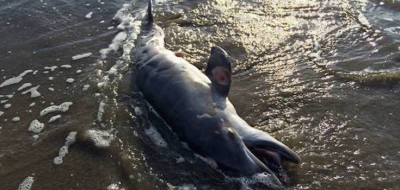Dolphin Deaths in Gulf Of Mexico Caused By Injuries from Petroleum Exposure

According to a recent government-backed study, the health complications, injuries, and deaths suffered by dolphins in the Northern Gulf of Mexico since the 2010 Deepwater Horizon oil spill are largely sparked by petroleum exposure.
“Deepwater Horizon oil spill of 2010, also called Gulf of Mexico oil spill of 2010, largest marine oil spill in history, caused by an April 20, 2010, explosion on the Deepwater Horizon oil rig—located in the Gulf of Mexico, approximately 41 miles (66 km) off the coast of Louisiana – and its subsequent sinking on April 22.”
So begins one of the most recent articles cataloguing yet another series of marine animal deaths which have occurred since the BP oil spill in the Gulf of Mexico (GOM). The April through July 2010 massive oil spill has left a legacy of dead and injured marine life that never seems to end.
“The scientists found most of the animals had lesions in their lungs and adrenal glands that caused many to die by disturbing their ability to regulate metabolism and blood pressure, and weakening their ability to fight infection.
“The animals all had “significant life-threatening abnormalities” that were “consistent with the effects of petroleum products,” said Kathleen Colegrove, a veterinary pathologist from the University of Illinois who participated in the research. [1]
Terrible: Gulf of Mexico Dead Zone Now Size of Connecticut
In spite of the indisputable scientific evidence, BP continues to deny any connection between their oil spill and the dead dolphins that washed up at Grand Isle, Louisiana. The oil company has consistently refused to accept evidence linking many other mass animal deaths on or near the coast of Louisiana to the historic Gulf oil spill.
Some environmental activists have observed that, were the true correlations revealed between the unparalleled spill and the toxicities found in seafood as well as other marine life, BP would face massive financial liabilities. Other health advocates have asserted that the many adverse health effects and medical conditions suffered by residents on the GOM coastline would also present an unprecedented degree of legal exposure for BP.
“The study is part of a process led by NOAA called Deepwater Horizon Natural Resource Damage Assessment. If studies find a link between the spill and any damage, BP will be expected to pay compensation, though the company can appeal findings in court.”
It’s no wonder that BP denies that “Lesions In Lungs Are Indicative of Oil Toxicity.”
There are many inconvenient truths that BP has refused to acknowledge about the Gulf oil spill and the millions of gallons of the dispersant Corexit that the company applied to the affected GOM waters. Some of those scientific facts concern the intensified toxicities associated with oil-treated with Corexit. Of course, the toxicities of petroleum and Corexit alone have also been well-documented for years.
As follows:
(1) 10.72 parts per million (ppm) of oil alone will kill 50% of the fish test species in a normal aquatic environment within 96 hours.
(2) 25.20 parts per million of dispersant (Corexit 9500) alone will kill 50% of the fish test species in a normal aquatic environment within 96 hours.
(3) 2.61 parts per million of dispersed oil (Corexit-laden) alone will kill 50% of the fish test species in a normal aquatic environment within 96 hours.
Very few realize, but powerful transnational oil companies like BP will always hide behind the corporate shield of limited liability even though they have been scientifically proven responsible for environmental damage or injury to human health.
In the case of the BP Gulf oil spill the widespread and profound destruction to coastal habitats and GOM ecosystems are still being assessed and documented. Some of the evidence of environmental devastation are only now being observed for the first time.
Likewise, time-delayed harm and injury to both marine and plant life are slowly emerging the further we get away from the worst oil spill in U.S. history.
Sources:
PHOTO: CAIN BURDEAU/ASSOCIATED PRESS
Follow us: @naturalsociety on Twitter | NaturalSociety on Facebook

